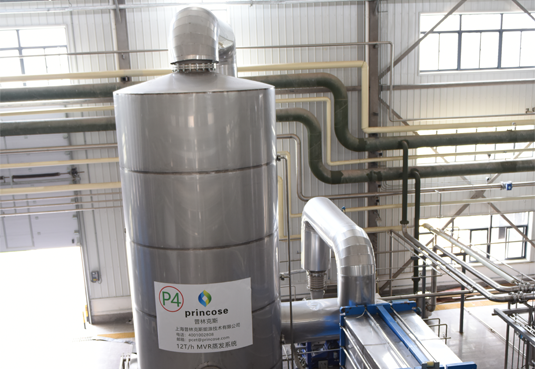
Plate Series
Plate single-effect evaporator Plate multi-effect evaporator Plate rising film evaporator Plate MVR (Mechanical Vapor Recompression) evaporator Plate TVR (Thermal Vapor Recompression) evaporator Plate rising film + forced circulation evaporator Plate 2+1 MVR evaporatorTube Series
Tube single-effect evaporator Tube multi-effect evaporator Tube falling film evaporator Tube forced circulation evaporator Tube MVR evaporator Tube TVR evaporator Tube 2+1 MVR evaporator
Industry and Application
Starch Sugar Sugar Alcohols (or polyols) Amino acids and amino acid salts Organic Acids Sucrose Fermented Products Inorganic Salt Crystallization Saline Wastewater Lithium battery Paper manufacturing, tobacco industry Juice Beverage Textile industry Chinese herbal medicine extraction
System Technology
Plate TVR multi-effect evaporation system Multi-Effect Plate MVR Evaporation System Single-Effect Plate MVR Evaporation System Tubular MVR Evaporation and Crystallization System Tubular Multi-Effect Evaporation System Single-Effect Tubular MVR Evaporation System Plate-Tube Combined TVR Evaporation System
Release time:2024.08.15 Article source:Princose



| The
selection of evaporator materials needs to consider various factors,
including the properties of the material, such as acidity, alkalinity,
chloride and fluoride ion content, corrosion resistance, operating conditions
(like temperature and pressure), and the performance requirements of the
equipment. Below are some common scenarios for the selection and application
of evaporator materials: I. Considering Material Properties Non-corrosive or Low-corrosive Materials: For materials that are non-corrosive or have low corrosion, carbon steel can be selected as the evaporator material. Carbon steel has a lower cost and is suitable for environments with no special requirements. Materials with Cleanliness Requirements or Mild Corrosion: For materials with cleanliness requirements or mild corrosion, 304 stainless steel is recommended. 304 stainless steel has good processing performance and toughness, can withstand temperatures up to 800°C, and is widely used in the industrial and furniture decoration industries. Materials with Strong Corrosion but Low Chloride Ion Content: In this case, 316L stainless steel is a better choice. 316L has a wide range of applications in the chemical industry due to its excellent corrosion resistance, especially after adding 2-3% Mo element, which enhances its corrosion resistance and is suitable for corrosion resistance requirements in high-temperature environments. Materials Containing Chloride Ions: For materials containing chloride ions, under acidic operating conditions, duplex stainless steel or titanium materials are more suitable choices. Duplex stainless steel, such as 2205 alloy, has high strength and good stress corrosion resistance, especially suitable for temperature ranges of -50°F to +600°F. Titanium materials, with their light weight, high strength, and strong corrosion resistance, excel in extremely corrosive environments. II. Considering Operating Conditions Temperature: Different materials have different high-temperature resistance properties, so the appropriate material needs to be selected based on the operating temperature. For example, 304 stainless steel can withstand temperatures up to 800°C, while titanium materials have a higher melting point and are suitable for higher temperature environments. Pressure: The design pressure of the evaporator is also one of the factors to consider when selecting materials. Some high-strength materials, such as duplex stainless steel and titanium, maintain stable performance in high-pressure environments. III. Considering Equipment Performance Requirements Corrosion Resistance: For evaporators that need to operate in corrosive media for a long time, materials with high corrosion resistance should be selected, such as 316L stainless steel, duplex stainless steel, or titanium. Cost: The selection of materials also needs to consider cost factors. Generally, titanium has the highest price, followed by duplex stainless steel and 316L stainless steel, while 304 stainless steel is relatively lower. Therefore, under the premise of meeting performance requirements, materials with lower costs should be selected as much as possible. IV. Comprehensive Evaluation and Selection In practical applications, the selection of evaporator materials often requires comprehensive evaluation based on specific conditions. This includes the properties of the material, operating conditions, equipment performance requirements, and cost, among other aspects. At the same time, factors such as the material's machinability, welding performance, and compatibility with other materials also need to be considered. In summary, the selection of evaporator materials is a comprehensive process that requires considering and balancing multiple factors. During the selection process, it is recommended to consult professional evaporator manufacturers or material suppliers to obtain more accurate advice and guidance. |
Rich experience in process planning and equipment manufacturing
Customized Process Solutions
The project scope ranges from experimental testing of material parameters, to determination of process plans, to drawing, procurement, manufacturing, installation, debugging, training, and ultimately equipment delivery

Career
Professional
build Brilliant
Future
Proficient in industry/Achieving the future



<ul id="8iy0e"></ul> <ul id="8iy0e"></ul> <tfoot id="8iy0e"></tfoot>


